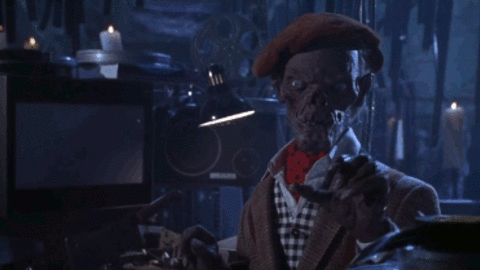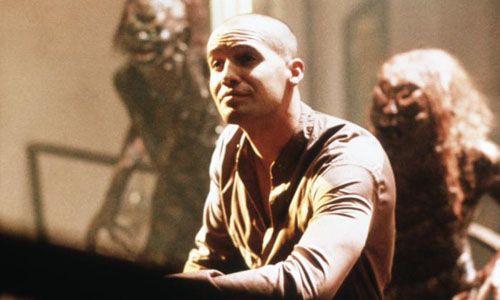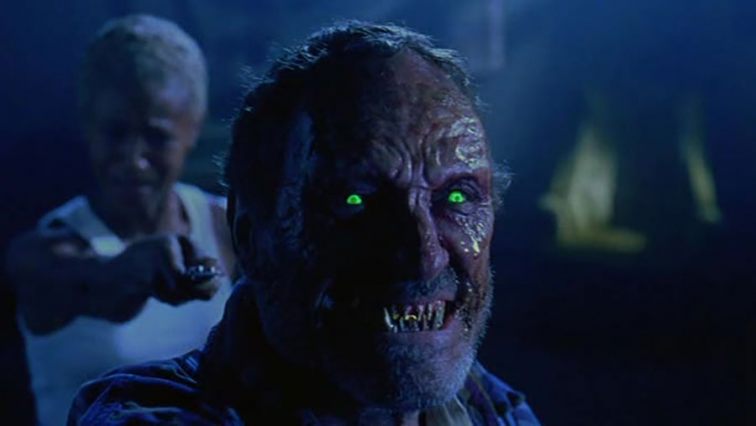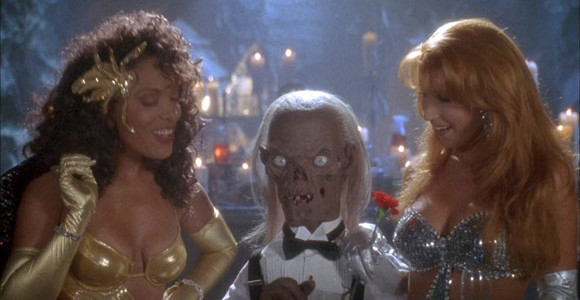
Hello kiddies, it’s your old pal The Cryptkeeper here. I’ve hijacked the pages of Deadly Grimehouse from those corpulent creeps Jaws Abrams and Mike Vanderboo-lt to talk about my favorite spook subject –me! Heh, heh, heh! It seems that in 1995, a young upstart by the name of Randall Boyll (and ghouls) had the audacity to try and turn my movie DEMON KNIGHT into a book. A Pocket Book, no less! It makes me so angry! To have the audacity to mince my frightful feature into wormy little words! Were the insidious images from the hit Universcare Pictures movie not enough? I ought to draw and quarter this fiendish fellow! On that note, I’ve asked my fearful friend, Nightmare Nathan Smith, to distill his thoughts on the book and the movie for your personal deadification! Let’s hope he doesn’t get long in the tooth. I call this twisted tale — From the Page to the Scream!
I’ve probably talked about this on Daily Grindhouse before, but when I was a kid in the early ’90s, Saturday nights meant I had an appointment with TALES FROM THE CRYPT on Fox 4, my local affiliate. I would watch the episode, heavily-edited for television of course, get scared out of my wits, and turn the dial to NBC to catch the last minutes of SATURDAY NIGHT LIVE just to cool my nerves in the hopes I wouldn’t experience nightmares.
That hardly ever worked.
I very distinctly remember the night that TALES FROM THE CRYPT didn’t even air, because the networks were covering the wreck that would claim the life of Princess Diana. I don’t remember ever reading anything about a feature-length film coming out — at that age, the only rag I read was Entertainment Weekly. There wasn’t anything in those putrid pages, and I still had yet to discover Fangoria (put down your pitchforks, folks). The night I discovered there was a TALES FROM THE CRYPT movie was during a late-night watch of the show. I can even tell you the episode that the advertisement for DEMON KNIGHT aired on: “Three’s A Crowd.” I was ten at the time, and I was floored that I was getting to see The Cryptkeeper on the silver screen. My uncle took me to see DEMON KNIGHT on opening weekend, at the Hollywood Theatre in Garland, Texas and it was love at first fright.
Now, what I didn’t know is that DEMON KNIGHT had a novelization. Yes, there were a metric ton of pages devoted to giving stay-at-home audiences the experience of the film they so desperately wanted to see, but without the displeasure of running into stoned punks and filthy drunks. You guys remember Todd Strasser? Yeah, he did a lot of these novelizations. On a side note: There’s a great YouTube channel called AUDIOBOOKS OF THE DAMNED, in which you get the audio version of many great horror hits. Anyhow, I was always sniffing around my local library in the paperback archives, when I found the novelization of DEMON KNIGHT, written by Randall Boyll, who would also do novelizations of SHOCKER,THE LONG KISS GOODNIGHT, and DARKMAN. Naturally, I checked it out as fast as I could, and read it just as quick. But I’m older now, and most of what I’d read has evaporated out of my skull. So, when I purchased the essential Blu-ray birthed by Scream Factory a while back, (the film holds up tremendously), I decided to hop to America’s Newest Library — Amazon — to find a copy of the novelization. Fortunately, I did find it and had it rushed to me immediately. It took me quite a stretch of time to dig into the throwback tome, but when I did I was curious to discover that some things were quite different from the film. Care to find out with me?
SPOILER ALERTS INBOUND – I know you’ve probably seen DEMON KNIGHT by this point, but the novelization is extremely different from the film in many, many ways – and I’ll be digging into the differences between the film and novel’s ending almost beat-by beat, so you might want to hop over to Amazon or Half Price Books, read the novel and then come back. I’ll leave the light on for you.

Like the lightning fast film it’s adapting, DEMON KNIGHT is filled with pulpy prose and it’s quick on its feet to boot. Boyll’s fantastically sharp descriptions really put you into the world of DEMON KNIGHT, (“He was fighting pink elephants, while the best half of you was drying up on your mama’s bedsheet.”) so much so that if you hadn’t seen the film, you can mentally realize his interpretation of the events as they unspool in your head. There’s a sense of the dying town of Wormwood that the film’s events go down in, and you get a sense of the lives that inhabit this husk of a homestead, the people waiting around and decaying while God chooses to use them as pawns in this eternal chess game between the light and the dark.
As is usually the case with literary adaptations of films, or vice versa, it’s truly hard not to read the words and not picture the actor we’ve so closely associated with that character. For The Salesman, you can see Billy Zane still perfectly essaying the character with his venomous vernacular and sneering grin, seeming less like a person than a serpent housed in human skin, but doesn’t have any of Billy Zane’s scene-stealing mania. Truthfully, he’s a bit like Pennywise The Dancing Clown – he’s always shifting into different costumes and telling bad jokes alongside them. He turns from matador when serenading Cordelia, a Catskills bandleader when seducing Uncle Willie to the dark side, and a fireman when he’s set his sights on Jeryline for the end of the whole shebang. For Jeryline, you still get the sense that she’s still perfectly spunky and smart (and bad) assed. But Jeryline as written in the book is a blonde, white woman whereas in the movie she’s perfectly realized by Jada Pinkett. A lot more time is given to her prison background (your garden variety crimes), but the sense of yearning to escape to Paris or whatever international land is better realized here. Hell, the reason we discover that there’s a basement (a secret in the book here, in the film, not so much)is because Jeryline used it as her own personal hiding space, a place to steal away from the cruel warden trapping her in the Mission Inn.Now, with Brayker, he’s pitch-perfect in both mediums. In the book, he’s similar to Roland Deschain of THE DARK TOWER series; a stoic and humorless soldier fighting an unending battle against evil and battling to keep Earth’s lights from turning out. In the film, he’s given a sense of warmth and humanity by virtue of being played by the eternally amazing William Sadler. I prefer the book’s interpretation, because as good as Sadler is with Brayker in the film, I feel the weight and weariness of the life he’s had as a demon knight. We know he’s going to die by virtue of having seen the film, but not only do we feel the sadness of his death, we feel the relief as well. On the last note, Brayker is buried in a pauper’s grave, which made me think of all those bozos who whined about Rey’s parents in THE LAST JEDI suffering the same lousy fate.

The plot plays out the same way as the film, but here it’s told in a more novelistic manner, rather than the short hand storytelling flourishes we’ve come to use when making a film. There’s always that great structural device where we end on suspenseful moments, where characters fates are left up in the air, and we leave the audience in terror wondering what will happen next. Truthfully, towards the end of the novel when the characters are splitting up -whereas in the film they clutter together until things go to hell – it begins to feel a little like THE THING. Is the person who disappeared for the long stretch of time one of The Salesman’s minions? Chances are if they were in the movie, they are here too. As most novelizations are written using earlier drafts, the story skirts on and off the path we know, but still stays within the line enough so that we’re pleased with how closely things are re-enacted. The events are the same, but the actions that get the key players – The Salesman (the name The Collector goes by here) and Brayker – are a little different and the way they interact with the characters who lead them there – the law enforcement and Uncle Wally, respectively, are similar but a tad changed though no worse for the wear.The method for which Roach grabs the key is different too. He pockets it during a faux squabble with Brayker, replacing the key with a Swiss Army Knife – which Brayker is forced to dispatch Uncle Willie with later. For instance, we know how Roach is killed in the movie – torn to shreds by the demons. Here, The Salesman materializes a Corvette out of thin air (Roach’s bargaining chip for the key) and drops it on Roach. Alas, this change means we would’ve missed the lovely cartoonish image of Billy Zane unfurling a sponge from his mouth.
The other characters are pretty much the same as we see them in the book – Cordelia’s still a prostitute, though I don’t seem to remember her as having a backstory of being an elementary school teacher. She’s also older and perhaps a little girthy than Brenda Bakke is in the film. The sheriff and deputy get some sketches of backstory (Deputy Martel was a physical fit military man here, rather than the husky cop played by Gary Farmer) and the Sheriff thinking his son is not his child, but rather a product of the wife snogging the next door neighbor. Roach … is still a dick, but younger, dumber and full of … cowardice. But the cowardice is balanced neatly with his true nature – survival for him and him alone. Ditto for Irene, though she soften her crudity and hard-edge as she’s driven into the thick of the madness.And Wally is still a put-upon, love-struck goober but still the burgeoning, mail stealing psychopath. The key (see what I did there) to all these characters is their desperation. Because the movie is fast and loose, we don’t have too much time to sit with the characters and really get inside their heads and learn what’s inside their hearts. Because they’re desperate for something more, anything more, you really believe that they’d buy the goods that The Salesman is peddling. Deputy Martel just wants to be the biggest shit in the smallest toilet. Would Jeryline sell everyone out for an escape to anywhere? Possibly. Her biggest fear is being imprisoned forever. Would Uncle Willie give the whole shebang away for a taste of Thunderbird? Most definitely. His nightmare is dying alone in an alley, suffering from delirium tremens. Would Roach give the key to The Salesman to save his worthless hide? You’re goddamn right he would.

Elsewhere, it’s the little details that add spice to the film we already love. The meta approach of the Cryptkeeper presenting DEMON KNIGHT as his own film is replaced by having us read his novel, DEMON KNIGHT (the book opens with his short story which resembles the short segment with John Larroquette that opened the feature), and there are little interludes that the Cryptkeeper offers up. We learn that Uncle Willie has a past as a silver investor, thus explaining why he knows his way around in the mines later on in the film. There’s this hobo lifestyle we get told in loving detail, like his interactions with the legendary hobo Fan-Belt, or the real highs that come from a can of Aqua Net. Or the slop that Brayker’s eating being revealed as blended up leftovers from that night’s supper, or what Brayker was up to before The Salesman confronted him (working in New York, for what it’s worth) and sent him into the latest battle. The demons are still your garden variety boogermen, but instead of shooting green lasers out of their eyes when they’re dispatched – they shoot white, viscous-y, venomous fluid out that burns anyone it comes into contact with. Oh, they also grow wings and fly! My favorite little character anecdote is that Uncle Willie knew that Wally had some nefarious plot afoot, but had his silence bought off with booze – which is perfectly in line with the character’s weaselly, booze-seeking nature. The blood seals are an interesting wrinkle here – first, it’s not just a drop of blood that causes a seal, you need a realistic amount of it to keep the demons out, but I love the way the old, clotted blood is easier to wipe away versus the way blood stains the surfaces it’s dropped on. It grounds the story believably. It makes it magical realism.
The ending is so different, it’s crazy! For instance, you have Deputy Martel and Irene’s fates – in the film, they go out with a hero’s death a la ALIENS, but in the novel Martel attempts to make a run for it in his cruiser with Irene in tow. Except instead of blowing himself up with a grenade, he’s killed by one of The Salesman’s illusions – a hippie whispering the lyrics to “Ohio” in his ear, blowing Martel’s head off with his misplaced revolver (lost during an earlier escape attempt). Then, the demon shifts into Martel’s form, drives the car up to Irene, lets her in the car and drops a live grenade into her hands, blowing the car up and thereby giving her the ol’ Shane Vendrell Special. Or Danny, for instance – whom disappears for a long time in the book, showing up after his parents are discovered in the mines. He ghosts the rest of the gang and then shows up later, and he’s possessed, though not by the TALES FROM THE CRYPT comic they find in the mission’s belfry. He’s really low-level, being killed off rather quickly and not contributing to Brayker’s demise (he rips Brayker up in the belfry, tonguing his innards in the film), though he wounds him by breaking his limbs up, not to mention the poor fella is singed by the burning remnants of the car explosion. Twice in one night! Worst run of luck since Nixon! But what changes is that The Salesman offers Brayker an out to leave! And though it’s revealed to be a tactic, Brayker does move to leave. And I would’ve bought it! Because of the tired, weariness the character presents, you could imagine someone in the same shoes walking away from it all. That little gambit was also deployed excellently in last year’s IT. The Salesman is ultimately responsible for killing Brayker, gutting the poor hero with his own butterfly knife. The rest playes out exactly like it does in the film, right up to Jeryline covering herself in Brayker’s blood, The Salesman washing it off, her spitting it in his face (in the novel, his destruction actually plays out a little like the way the hand is killed in IDLE HANDS, actually. He kind of poofs out of existence) and being followed onto a new bus by another Salesman.

But I highly recommend this novelization as a quick literary companion to the excellent feature film. DEMON KNIGHT is a studio-produced throwback to ‘eighties-style excess like EVIL DEAD II or RE-ANIMATOR, one that was based on a hot cable property with some all-star producers attached. For this film, everything aligns in just the right way (similar to the way that Brayker’s tattoo aligns to signal the darkest night of his life) to give us in the audience a true rollercoaster ride. You’ve got gore, gratuitous nudity, perfectly-placed puns, and a film that has a sense of humor — something that horror would gradually lose over the next decade. Most importantly, DEMON KNIGHT had weight to it. It wasn’t afraid to slow down the action for religious philosophy.The book serves to enhance all this in the best way. Moreover, novelizations themselves are a throwback to how we used to consume our pop culture. Do we even have those anymore?
It’s a shame that BORDELLO OF BLOOD fell flat on its face so soon afterwards. We could’ve had something special on our hands. Instead, we’ve got a bonafide cult hit and a less-than-stellar follow-up with Dennis Miller wielding a Super Soaker. Did we get a BORDELLO OF BLOOD novelization? No, I didn’t think so. At least the Word Processor of the Gods spared us the indignity of having to see a writer suffer through emulating the “comedy” of Dennis Miller for two-hundred-plus interminable pages. The less said about RITUAL, the better.
Tags: Billy Zane, Brenda Bakke, C. C. H. Pounder, Charles Fleischer, Chasey Lain, Cyrus Voris, Dick Miller, EC Comics, Ernest Dickerson, Ethan Reiff, Gary Farmer, Gilbert Adler, Jada Pinkett Smith, John Kassir, John Larroquette, John Schuck, Mark Bishop, Randall Boyll, Thomas Haden Church, Todd Strasser, Traci Bingham, William Sadler


No Comments